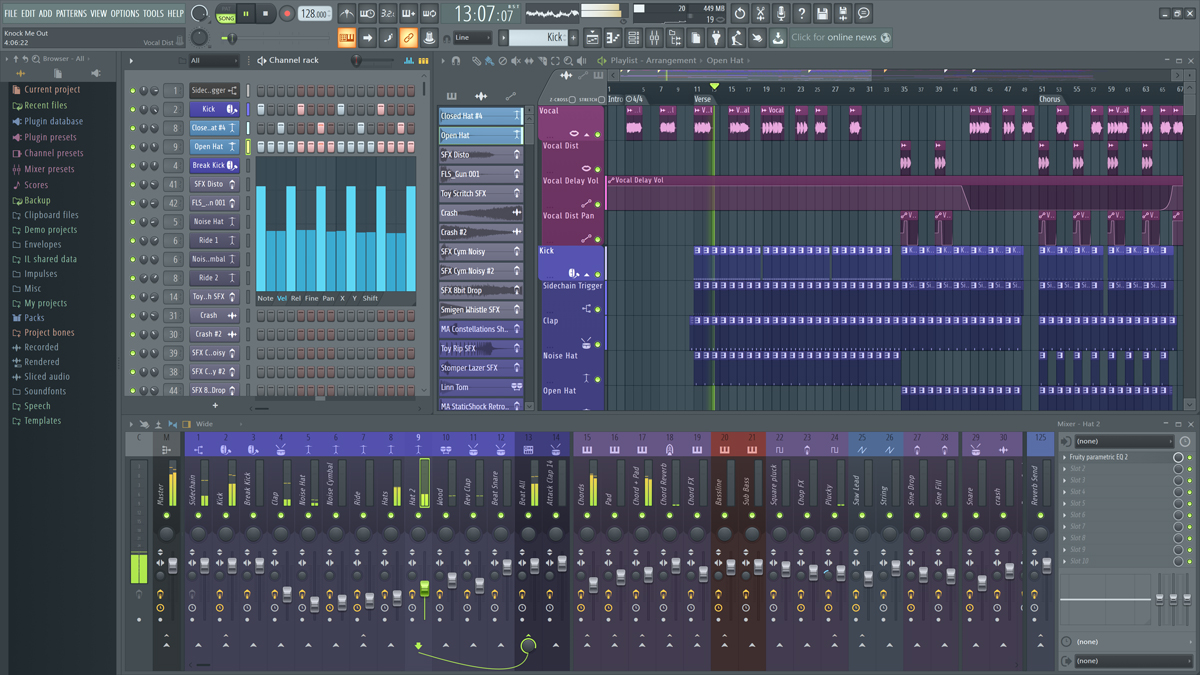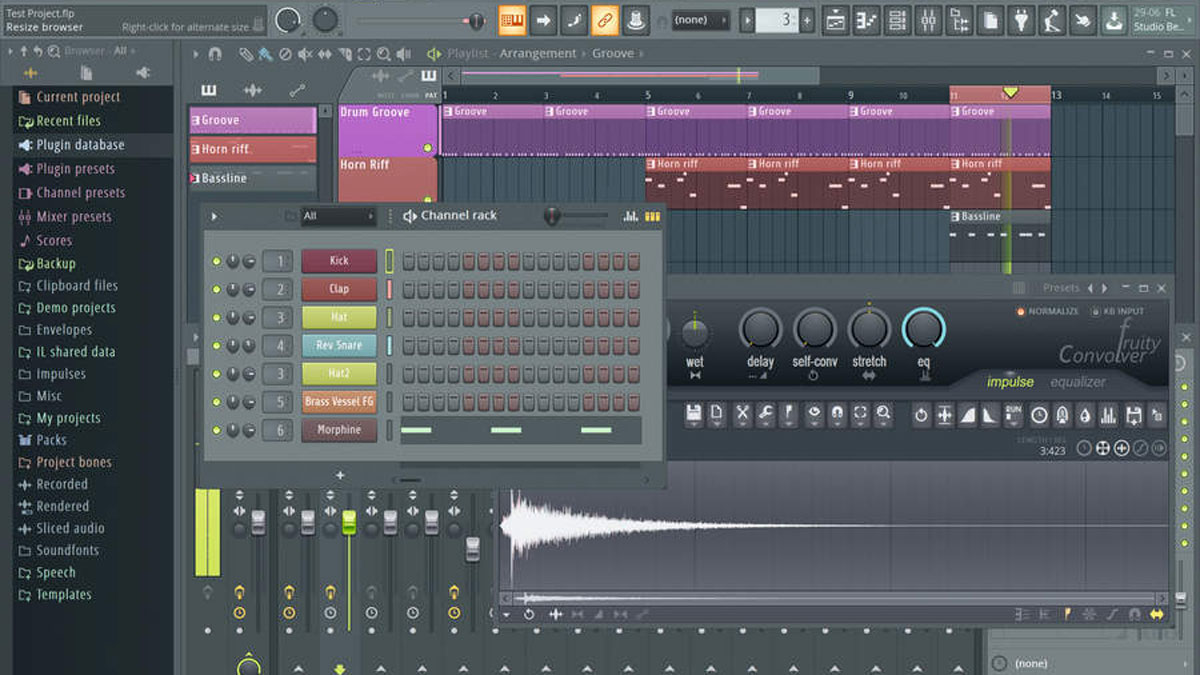MusicRadar Verdict
On its 20th anniversary FL Studio is a powerful and inspirational application - and a welcome addition to the Mac realm!
Pros
- +
Multiple Arrangements are really inspiring and a great workflow addition.
- +
Time signature markers are well implemented.
Cons
- -
UI can still feel a little cluttered and imposing.
MusicRadar's got your back
Few software applications can claim the sort of cultural cachet that FL Studio has.
Originally launched as FruityLoops - a title it’s often still colloquially known by - and inspired by Propellerhead’s much-loved Rebirth app, the loop-sequencer-turned-DAW holds a near-iconic status for a certain generation of producers, particularly in hip-hop and EDM realms. However, while it undoubtedly has legions of fans, historically FL Studio has been a PC-only affair.
All that changes with FL Studio 20 (which, confusingly is actually version 13, but titled for the software’s 20th anniversary). The headline feature here is a native 64-bit Mac version, meaning that FL Studio can now be used on OS X/MacOS without the need for a clunky work-around. Pleasingly, licenses are shared between both Mac and PC versions.

Image-Line already offers lifetime free upgrades to all FL Studio users, meaning that all existing users of the software now automatically own upgrades to version 20 on both platforms. Because of this - and some excellent new features, which we’ll come to later - version 20 is a complete no-brainer for existing users. What about newcomers though? In 2018, does the DAW formerly known as FruityLoops still have enough about it to tempt Mac users into the fold?
Coming to FL Studio for the first time from another DAW can be a slightly jarring experience. While the application has come on a long way from its early days as a basic loop sequencer - it easily holds its own against rival DAWs on the feature front - it still shows its roots in its layout and work flow. Whereas the bulk of mainstream DAWs see users work across a single timeline or workspace, FL Studio splits creative, mixing and arrangement duties into independent sections, each with its own UI window.
The main arrangement space is known as the Playlist, which is used to sequence patterns of audio, MIDI and automation which are created in the Channel Rack. This latter section is also used for selecting instruments and plugins as well as routing audio to the Mixer. Each instrument in the Rack gets its own simple X0X-style step sequencer, which can be expanded to a pop-out piano roll for more complex sequencing duties.
FL Studio 20 is available in four different versions: Fruity, Producer, Signature and All Plugins Bundle. The Fruity edition is the cheapest at 89 euros, and contains the core functionality but lacks audio capabilities and some of the more advanced plugins. The Producer and Signature edition cost 189 and 289 euros respectively - both have full audio capabilities, but the latter comes with an increased selection of plugins, including things like the Pitch & Time editor and Harmless additive synth. Finally, the All Plugins Bundle comes in at 826 euros and comes with Image-Line’s entire arsenal of instruments and effects, including things like the Drumaxx drum machine and Harmor, Morphine and Toxic Biohazard synths - all of which are excellent, even if they’re a little on the old side now. Most of the plugin instruments are available for purchase individually too.
Audio from the Channel Rack is then routed to the Mixer, where each track gets its own channel strip complete with insert plugin slots for effects processing. Unusually, Mixer tracks in FL Studio aren’t bound to specific tracks in the Playlist, but are only linked to instrument routings coming from the Channel Rack. Similarly, Patterns aren’t limited to making use of just one instrument in Rack, but can sequence multiple elements across a single clip. As a result, it’s possible to think of arrangement, creation and mixing as independent work flow elements.
Want all the hottest music and gear news, reviews, deals, features and more, direct to your inbox? Sign up here.
This fragmented creative approach has pros and cons. For one, it means there’s a lot going on within the FL Studio interface. Fortunately, things are very flexible, so each window element can be hidden as needed. The DAW got a major visual upgrade for version 12, with a switch to vector graphics throughout, and the ability to smoothly resize windows is great. We must admit though, we still find FL Studio’s pop-up heavy interface somewhat stress-inducing.
From a work flow point of view though, it can prove inspirational in certain situations. It’s no coincidence that FL Studio is popular with hip-hop and dance music producers. Its focus on Patterns, acting like building blocks to arrange with, really suits genres with an emphasis on loops, builds and breakdowns. It encourages a work flow focused on grooves and riffs more than long recordings.
There are certain elements of the work flow that those used to rival DAWs may find clunky. The need to load up new windows for many sequencing and editing duties, for example, rather than simply make edits within a timeline. There’s a heavy emphasis on toolbars and menus too, so those not fully schooled on their keyboard shortcuts might find tweaking and editing a little slow to begin with.
Workspace aside, FL Studio is a very well-equipped DAW. The selection of included effects plugins is excellent, with highlights including the Convolver convolution reverb and a strong selection of delay tools. New users will find a lot to like in the great sequencing and MIDI creation touches too, such as the inspirational Riff Machine, and the neat Graph Editor - which makes a welcome return for this version, having been dropped from FL Studio 12. These are just a few features from a comprehensive list though.
So what’s new? Most of the headline features for version 20 come to the software’s Playlist section. The highlight here is the addition of multiple Arrangements. This gives each project an unlimited number of alternative versions of the Playlist, which users can flip between to use as sketchpads or create variations on their current track. It’s a really nice bit of functionality that makes it very easy to experiment with arrangements without worrying about breaking existing compositions. It’s easy to copy an existing Arrangement, and you can even consolidate multiple arrangements to bring your favourite elements into a single Playlist space.
The Mac version of FL Studio is 64-bit only, and requires OS 10.11 or later - not great for older Macs, but a fair compromise at this point in time. Stability wise, FL ran solidly on my mid-2015 MacBook Pro, though we noticed some playback glitches when changing plugin presets. Setup and registration was easy. On Mac, FL supports VST and AU plugin formats, and we had no problems with any of the third party instrument or effects.
There are a few elements of FL Studio yet to be ported across for the Mac version. At the time of writing, Mac users can’t load FL Studio 20 as a VST client in a third party host, unlike on Windows systems. Rewire support is absent too. Image-Line says the former is currently being worked on. Several plugins are currently unavailable. Some, like the FL Studio Mobile plugin, Dashboard and Blood Overdrive are being worked on; other older tools, like Fruity LSD or the WASP synth won’t be making the jump at all. Some other Image-Line plugins are available on Mac within FL Studio, but are yet to be made available as standalone VSTs. For details of what is/isn’t available, head to: bit.ly/image-line_comp
On that subject, flexible consolidation capabilities are another highlight of this version. This gives users several options for bouncing instruments or samples down to single audio les. There are options to bounce down full Playlist tracks, selections from the Playlist or individual Patterns from the Rack.
There are further tweaks to the Playlist too. For one thing, the number of available tracks has increased with this version, from an already fairly generous 199 to a maximum of 500. To help keep those masses of tracks getting too cluttered, you can now hide track groups.
FL Studio also now presents a visual representation of audio when recording into the Playlist. On the recording front, when recording in looped mode, multiple takes are now automatically copied to new tracks and grouped, which is handy for keeping track of multiple variations.
Multiple time signature options for both the Playlist and individual Patterns is another welcome new feature. This allows users to add markers to the Playlist which initiate a shift in time signature. You can also set time signatures for individual Patterns, and even change timings mid Pattern using the Piano Roll. Patterns can be set to follow time sig changes marked on the Playlist too.
While there’s not much in the way of new sounds or effects, a few plugins have been updated, such as Fruity Reeverb 2, which gets a Speed control for refining the sound, and the Convolver, which gains a pair of presets allowing it to act as a Linear Phase EQ. There are a good number of other small tweaks and quality of life improvements across the board, from an improved plugin delay compensation system to general bug fixes for a host of FL Plugins and numerous other small changes.
The question of whether these changes make FL Studio 20 a worthwhile upgrade for existing users is a moot point; thanks to Image- Line’s excellent policy of giving all users free lifetime upgrades, all existing users automatically get the new versions for free. That aside though, while some longtime users may bemoan a lack of major new plugins or tools, the Playlist and Pattern improvements are excellent, and make this a really worthwhile update. The Arrangements feature in particular is a bit of a revelation, and really suits FL’s work flow, making it more flexible and fun than ever to throw together patterns and loops in weird and exciting ways.
As for new users, FL Studio is very much worth your attention. It makes a great addition to the Mac realm too. It’s a slight shame that you can’t currently use FL Studio as a VST or Rewire client on Mac, or use it with the FL Studio Mobile companion - the flexibility brought by these three features is one of my favourite things about FL Studio. The VST capability in particular makes it a great choice for a secondary DAW, allowing it to be used as a sketchpad in a manner similar to NI Maschine.
Most of these are all things Image-Line is working on, and there’s still a lot that’s appealing about FL Studio. Plus, the offer of a lifetime of free upgrades once you’ve bought in once is very tempting.
I'm the Managing Editor of Music Technology at MusicRadar and former Editor-in-Chief of Future Music, Computer Music and Electronic Musician. I've been messing around with music tech in various forms for over two decades. I've also spent the last 10 years forgetting how to play guitar. Find me in the chillout room at raves complaining that it's past my bedtime.
